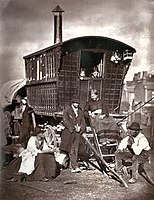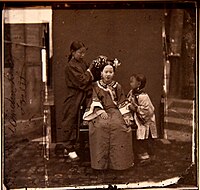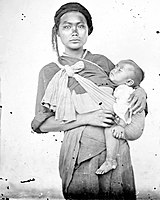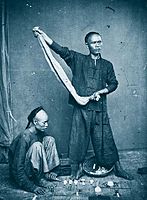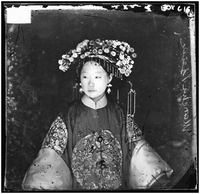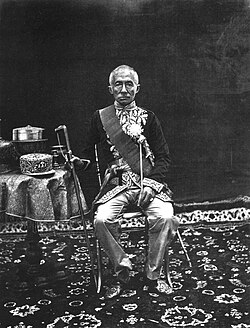John Thomson (fotograf)
| John Thomson | |
|---|---|
 | |
| Narození | 14. června 1837 Edinburgh |
| Úmrtí | 29. září 1921 (ve věku 84 let) Londýn |
| Příčina úmrtí | infarkt myokardu |
| Místo pohřbení | Tooting |
| Alma mater | Heriot-Watt University |
| Povolání | fotograf, spisovatel, fotoreportér, geograf a světoběžník |
| Děti | John Newlands Thomson |
| Ocenění | Fellow of the Ethnological Society of London |
| Některá data mohou pocházet z datové položky. | |


John Thomson (14. června 1837 Edinburgh – 29. září 1921 Londýn[1]) byl skotský průkopník fotografie, geografie a cestovatel. Byl jedním z prvních fotografů, který cestoval na Dálný východ, dokumentoval tamní obyvatele, krajinu a artefakty východních kultur. Po návratu domů dokumentoval život lidí na ulicích Londýna a série snímků je považována za klasický příklad sociálního dokumentu, který položil základy fotožurnalistiky. Byl oficiálním portrétním a dvorním fotografem vysoké společnosti v Mayfairu. Královské oprávnění (Royal Warrant of appointment) získal v roce 1881.
Mládí
Narodil se jako syn Williama Thomsona, maloobchodníka s tabákem a jeho manželce Isabelle jako osmý z devíti dětí v Edinburghu ve Spojeném království v době vlády královny Viktorie. Vzdělávání absolvoval na počátku 50. let a nejprve pracoval v oboru optické a vědecké přístroje u výrobce Jamese Mackaye Brysona. Během této doby se Thomson naučil principy fotografování a studium dokončil po roce 1858.
Během této doby také absolvoval dva roky večerních kurzů na umělecké škole Watt Institution and School of Arts (dříve Edinburgh School of Arts, později Heriot-Watt University). Obdržel "Osvědčení o způsobilosti" v oboru přírodní filozofie v roce 1857, v matematice a chemii v roce 1858. V roce 1861 se stal členem Royal Scottish Society of Arts a v roce 1862 se rozhodl odcestovat na Singapur se svým starším bratrem hodinářem a fotografem Williamem.
První cesty
V dubnu 1862 Thomson odjel z Edinburghu do Singapuru, kde pak strávil deset let cestováním po Dálném východě. Zpočátku založil společný obchod s Williamem na výrobu námořních chronometrů a námořních optických přístrojů. Založil také fotografický ateliér v Singapuru, kde portrétoval evropské obchodníky a inspiroval v nich zájem o místní obyvatele a pozoruhodnosti. Hodně cestoval po celém kontinentálním území Malajsie a na ostrově Sumatra, putoval po vesnicích, fotografoval přírodní národy a dokumentoval je při jejich činnosti.
Po návštěvě Ceylonu a Indie, kde od října do listopadu 1864 dokumentoval škody způsobené nedávným cyklonem, prodal Thomson své studio v Singapuru a přestěhoval se do Siamu. Po příjezdu do Bangkoku v září 1865 začal pracovat na sérii fotografií Krále Siama a dalších vysoce postavených členů královského dvora a vlády.
Inspirován znovuobjevením antického města Angkor v kambodžské džungli Henrim Mouhotem, se Thomson rozhodl podniknout první ze svých nejvýznamnějších fotografických výprav. Vyrazil v lednu 1866 se svým překladatelem H. G. Kennedym, britským konzulárním úředníkem v Bangkoku, který Thomsonovi zachránil život, když se během cesty nakazil malárií. Oba muži strávili dva týdny v Angkoru, kde Thomson bohatě dokumentoval rozsáhlý počet míst, čímž vytvořil první fotografické základy dnešního světového kulturního dědictví World Heritage Site - UNESCO.
Thomson pak odjel do Phnompenh a před cestou do Saigonu fotografoval kambodžského krále a další členy královské rodiny v Kambodži. Odtud krátce pobýval v Bangkoku, než se pak vrátil do Británie v květnu nebo červnu v roce 1866. Doma Thomson přednášel pro Britskou asociaci a publikoval své fotografie ze Siamu a Kambodži. Stal se členem etnologické společnosti Royal Ethnological Society of London, v roce 1866 Royal Geographic Society a začátkem roku 1867 publikoval svou první knihu The Antiquities of Cambodia.
Cesta do Číny & Tchaj-wan

Po roce stráveném v Británii Thomson opět pocítil touhu vrátit se na Dálný východ. Do Singapuru se vrátil v červenci roku 1867, předtím, než se odstěhoval do Saigonu na tři měsíce a nakonec se usadil v Hongkongu v roce 1868. Založil studio v budově Commercial Bank a další čtyři roky fotografoval portréty Číňanů a dokumentoval rozmanitost čínské kultury.
Thomson intenzivně cestoval po celé Číně, od jižních obchodních přístavů v Hongkongu a Kantonu, přes města Peking a Šanghaj, Velkou čínskou zeď na severu a hluboko do centrální Číny. Od roku 1870 do 1871 pobýval ve Fu-ťien, cestoval po řece Fujian s lodí amerického protestantského misionáře reverenda Justuse Doolittla a pak navštívil Amoy a Šan-tchou.
Navštívil ostrov Tchaj-wan (tehdy Formosa) s misionářem Dr. Laidlawem Maxwellem, na začátku dubna 1871 poprvé přistáli na Takao. Oba navštívili tehdejší hlavní město Taiwanfu před cestou k domorodým vesnicím na západních pláních ostrova. Po odchodu z Formosy Thomson strávil další tři měsíce cestováním 3000 mil po řece Jang-c’-ťiang a dosáhl Chu-peje a S’-čchuanu.
Thomsonovo cestování po Číně bylo často nebezpečné, protože navštívil vzdálené, téměř neosídlené oblasti daleko ve vnitrozemí. Většina lidí, se kterými se setkal, ještě nikdy neviděla člověka ze Západu, nebo fotoaparát. Jeho expedice byla kvůli fotografování obzvláště náročná. Museli přepravovat objemný dřevěný fotoaparát, mnoho velkých, křehkých skleněných desek a potenciálně výbušné chemikálie. Při fotografování v nejrůznějších podmínkách se často muselo improvizovat, protože chemické látky bylo v tamějších oblastech obtížné získat. Jeho témata byla nesmírně pestrá: od skromných žebráků a pouličních lidí, přes úředníky mandariny po prince a vysoké vládní úředníky, od odlehlých klášterů až po císařské paláce, od jednoduchých vesnic po nádherné krajiny.
Pozdější život
Thomson se vrátil do Anglie v roce 1872, usadil se v londýnském Brixtonu a kromě závěrečné fotografické cesty na Kypr v roce 1878, Thomson nikdy zemi neopustil. Během následujících let se věnoval veřejným přednáškám a prezentaci výsledků svých cest po Dálném východě. Jeho publikace začaly nejprve v měsíčnících, později následovaly série velkých, bohatě ilustrovaných fotografických knih. Hodně psal na fotografická témata, přispíval mnoha články do fotografických časopisů, jako například British Journal of Photography. Také přeložil a upravil knihu Gastona Tissandiera History and Handbook of Photography (Fotografie - historie a průvodce) z roku 1876, ze které se stala standardní referenční práce.
V Londýně spolupracoval s radikálním novinářem Adolphem Smithem, se kterým se od roku 1866 znali z redakce Royal Geographic Society. Společně pracovali při výrobě měsíčníku Street Life in London v letech 1876–1877. Projekt dokumentoval textem a na fotografiích životy lidí z ulice Londýna a jednalo se o průkopnické využití sociální dokumentární fotografie ve fotožurnalistice. Série fotografií byla později vydávána v knižní formě v roce 1878 pod stejným názvem: Street Life in London a je považována za klíčové dílo v historii dokumentární fotografie.
- The Crawlers, Londýn, 1876–1877
- Street Life in London, 1877
- Street Life in London, 1877
- Street Life in London, 1877
- John Thomson a Adolphe Smith: Street Life in London, 1877
Poté, co měl zavedenou pověst významného fotografa si v roce 1879 otevřel portrétní ateliér v ulici Buckingham Palace Road, později se přestěhoval do Mayfair. V roce 1881 byl jmenován oficiálním fotografem britské královské rodiny královny Viktorie a jeho pozdější práce se soustředila na studiové portréty bohatých a slavných z lepší společnosti, což mu umožnilo pohodlný život. Od ledna 1886 začal instruovat průzkumníky z Královské geografické společnosti v použití fotografie pro dokumentování jejich cest.
Po odchodu z komerčního studia v roce 1910 Thomson strávil většinu svého času v Edinburghu a pokračoval v psaní děl na téma využití fotografie pro Královskou geografickou společnosti. Zemřel na infarkt v roce 1921 ve věku 84 let.
Dědictví a odkaz
Thomson vynikal jako fotograf v mnoha oblastech: krajiny, portréty, pouliční fotografie, fotografování architektury, jeho odkazy je jedinečný svou vynikající kvalitou a šíří záběru. Jeho fotografie z Dálného východu z období viktoriánské Británie dávají zprávu o obyvatelích země a kultury v Číně a jihovýchodní Asii. Jeho průkopnická práce dokumentuje sociální podmínky lidí z londských ulic, kde se ukázal jako jeden z průkopníků fotožurnalistiky a jeho publikační činnosti jej umožňuje označit jako inovátora kombinace fotografie a tištěného slova. Pro své snímky volil nejčastěji techniku kolodiového procesu.
Na počest uznání jeho práce byl po jeho smrti v roce 1921 jeden z vrcholů Kilimandžára pojmenován Point Thomson (4995 m).[2] Některé z jeho děl lze spatřit na ústředí Královské geografické společnosti v Londýně, několik fotografií vlastní také Victoria and Albert Museum.
Vybrané publikace
- China Through the Lens of John Thomson 1868 -1872, River Books 2010.
- The antiquities of Cambodia, 1867
- Views on the North River, 1870.
- Foochow and the River Min, 1873.
- Illustrations of China and its people, 1873-1874
- Street life in London, 1878
- Through Cyprus with a camera in the autumn of 1878, 1879
- Through China with a camera, 1898
Vybrané fotografie
- Řezba z chrámu Angkor Wat, 1866
- Manchu women being sold hair ornaments. John Thomson. Čína, 1869. The Wellcome Collection, Londýn
- A Cantonese boat girl. John Thomson. Čína, 1869. The Wellcome Collection, Londýn
- Manchu lady having her hair styled. John Thomson. Čína, 1869. The Wellcome Collection, Londýn
- Old Chinese woman with elaborate hair style. John Thomson. Čína, 1869. The Wellcome Collection, Londýn
- Mandarin and son. John Thomson. Čína, 1869. The Wellcome Collection, Londýn
- A painter at work. John Thomson. Honk Kong, 1871. The Wellcome Collection, Londýn
- A Pekingese chiropodist. John Thomson. Čína, 1869. The Wellcome Collection, Londýn
- A Baksa woman and child, Formosa, 1871
- Formosa, 1871
- Takow harbour, 1871
- Pouliční hráči, asi 1868 - 1871
- Princ Kung, 1872
- "Hookey Alf" z Whitechapel, 1876 - 1877
- Král Mongkut Siamský, Bangkok (v evropském obleku), 1865 - 1866
- Čína: Nevěsta Manchu, 1871
Odkazy
Reference
- ↑ http://www.answers.com/topic/john-thomson-5
- ↑ Archivovaná kopie. academic.reed.edu [online]. [cit. 2011-07-10]. Dostupné v archivu pořízeném z originálu dne 2009-02-20.
Související články
Literatura
- The Photographs of John Thomson - Digital Library - National Library of Scotland [online]. [cit. 2008-03-14]. Dostupné v archivu pořízeném dne 2007-07-04. (anglicky)
- Thomson Biography, The Reed Institute [online]. [cit. 2006-05-27]. Dostupné online. (anglicky)
- John Thomson: China and London [online]. [cit. 2006-05-27]. Dostupné v archivu pořízeném dne 2006-02-14. (anglicky)
Externí odkazy
 Obrázky, zvuky či videa k tématu John Thomson na Wikimedia Commons
Obrázky, zvuky či videa k tématu John Thomson na Wikimedia Commons - The photographs of John Thomson @ National Library of Scotland Archivováno 9. 9. 2020 na Wayback Machine.
- Photographs at The Victoria & Albert Museum
- Biography and photographs at the Wellcome Library Archivováno 5. 11. 2012 na Wayback Machine.
- Photographs from an exhibition, 10 Chancery Lane Gallery
Média použitá na této stránce
A Cantonese boat girl. John Thomson. China, 1869. The picture is housed in the Wellcome Collection and is on display. The original black&white picture is ©Wellcome Trust.
Autor: Osama Shukir Muhammed Amin FRCP(Glasg), Licence: CC BY-SA 4.0
Old Chinese woman with elaborate hair style. John Thomson. China, 1869. The picture is housed in the Wellcome Collection and is on display. The original black&white picture is ©Wellcome Trust.
Autor: Peabody Essex Museum 迪美博物馆 , Licence: CC BY 3.0
John Thomson (British, 1837-1921)
Island Pagoda, about 1871, from the album, Foochow and the River Min Published in London, 1873 Carbon print Gift of the Estate of Mrs. Anthony Rives, 1973. PH26.19 Peabody Essex Museum
Today known as Jinshan Temple (金山寺)John Thomson: PINCE KUNG, now about forty years of age, is the sixth son of the Emperor Tao Kwang, who reigned from A.D. 1820 to 1850. He is a younger brother of the late Emperor Hien-foong, and, consequently an uncle to the reigning Emperor Tung-che. Prior to 1860 he was little known beyond the precincts of the Court: but, when the Emperor fled from the summer palace, it was he who came forward to meet the Ministers of the Allied Powers, and negotiate the conditions of peace. He holds several high civil and military appointments, the most important that of member of the Supreme Council, a department of the Empire resembling most nearly the Cabinet with us. Quick of apprehension, open to advice, and comparatively liberal in his views, he is the acknowledged leader of that small division among Chinese politicians who are known as the party of progress.
Independently of his various offices, Prince Kung, as his title denotes, is a member of the highest order of Chinese nobility; an expression which, to prevent misconception, we must beg our readers' permission to explain. There have been from the most ancient times in China five degrees of honour, to which men whose services have been eminent may attain; the titles vesting, as we should say, in remainder to their heirs male. The latter, however, cannot succeed without revival of their patent, and even then, as a rule, the title they succeed to is one degree less honourable than that of their predecessor ; so that were the usage in vogue with us a dukedom would dwindle to a baronetcy in five generations.
The Manchu family, which rules the country, or to speak more correctly those of the stock who are within a certain degree of the Imperial line, have no less than eighteen orders of nobility, liable, however, like the old system spoken of above, to gradual extinction, except in a few particular instances where the patent ensures the title in perpetuity.
Prince Kung received such a patent in 1865.From 'Street Life in London', 1877, by John Thompson and Adolphe Smith
…How different is the Covent Garden of to-day, with its bustle and din, its wealth and pauperism, its artifices, its hot-house flowers and forced fruit, its camellias with wire stems, its exotics from far-off climes, to "the fair-spreading pastures," measuring, according to the old chronicle, some seven acres in extent, where the Abbots of Westminster buried those who died in their convent. In those days vegetables were not only sold here but grew on the spot; and the land, now so valuable, was considered to be worth an annual income of £6 6s. 8d., when given by the Crown to John Russell, Earl of Bedford, in 1552…
…When death takes one of the group away, a child has generally beenr eared to follow in her parents' footsteps; and the" beat" in front of the church is not merely the property of its present owners, it has been inherited from previous generations of flower-women. Now and then a stranger makes her appearance, probably during the most profitable season, but as a rule the same women may be seen standing on the spot from year' s end to year's end, and the personages of the photograph are well known to nearly all who are connected with the market…
For the full story, and other photographs and commentaries, follow this link and click through to the PDF file at the bottom of the description archives.lse.ac.uk/Record.aspx?src=CalmView.Catalog&i...
Street Life in London, published in 1876-7, consists of a series of articles by the radical journalist Adolphe Smith and the photographer John Thomson. The pieces are short but full of detail, based on interviews with a range of men and women who eked out a precarious and marginal existence working on the streets of London, including flower-sellers, chimney-sweeps, shoe-blacks, chair-caners, musicians, dustmen and locksmiths. The subject matter of Street Life was not new – the second half of the 19th century saw an increasing interest in urban poverty and social conditions – but the unique selling point of Street Life was a series of photographs ‘taken from life’ by Thomson. The authors felt at the time that the images lent authenticity to the text, and their book is now regarded as a key work in the history of documentary photography.
Autor: Osama Shukir Muhammed Amin FRCP(Glasg), Licence: CC BY-SA 4.0
Manchu lady having her hair styled. John Thomson. China, 1869. The picture is housed in the Wellcome Collection and is on display. The original black&white picture is ©Wellcome Trust.
King Mongkut of Siam, Bangkok (European Dress), 1865 - 1866. Original version: Modern albumen print from wet-collodion negative, by John Thomson. Current version: unknown medium
From 'Street Life in London', 1877, by John Thompson and Adolphe Smith
…Despite the traditional hoarse voice, rough appearance, and quarrelsome tone, cab-drivers are as a rule reliable and honest men, who can boast of having fought the battle of life in an earnest, persevering, and creditable manner. Let me take, for instance, the career, as related by himself, of the cab-driver who furnishes the subject of the accompanying illustration. He began life in the humble capacity of pot-boy in his uncle's public-house, but abandoned this opening in consequence of a dispute, and ultimately obtained an engagement as conductor from the Metropolitan Tramway Company. In this employment the primary education he had enjoyed while young served him to good purpose, and he was soon promoted to the post of time-keeper. After some two years' careful saving he collected sufficient money to buy a horse, hire a cab, and obtain his licence…
For the full story, and other photographs and commentaries, follow this link and click through to the PDF file at the bottom of the description archives.lse.ac.uk/Record.aspx?src=CalmView.Catalog&i...
Street Life in London, published in 1876-7, consists of a series of articles by the radical journalist Adolphe Smith and the photographer John Thomson. The pieces are short but full of detail, based on interviews with a range of men and women who eked out a precarious and marginal existence working on the streets of London, including flower-sellers, chimney-sweeps, shoe-blacks, chair-caners, musicians, dustmen and locksmiths. The subject matter of Street Life was not new – the second half of the 19th century saw an increasing interest in urban poverty and social conditions – but the unique selling point of Street Life was a series of photographs ‘taken from life’ by Thomson. The authors felt at the time that the images lent authenticity to the text, and their book is now regarded as a key work in the history of documentary photography.
Autor: John Thomson , Licence: CC BY 4.0
Baksa, Formosa [Taiwan]. Photograph by John Thomson, 1871.
Iconographic Collections
Keywords: J. Thomson
This photograph by the great Scottish traveler, geographer, and photographer John Thomson (1837-1921) shows a young woman of the Manchu ethnic group in her wedding dress. She is dressed in a richly embroidered costume and a large floral headdress with tassels. Her face is powdered white. As an ethnographer, Thomson took many photographs of brides in lavish costumes, but he also expressed a gloomy view of the brides’ future lives, which he compared to slavery. "No Manchu maiden can be betrothed until she is fourteen years of age. Usually some elderly woman is employed as a go-between to arrange a marriage, and four primary rules exist to guide the matron. First the lady must be amiable. Secondly she must be a woman of few words. Thirdly she must be of industrious habits, and lastly she must neither want a limb nor an eye and indeed she must be moderately good-looking." Thomson also wrote that the wife “is even liable to be beaten by her mother-in-law, and husband too, if she neglects to discharge her duties as general domestic drudge.” Thomson’s collection of more than 600 glass negatives, made between 1868 and 1872, was acquired by Henry S. Wellcome in 1921.
Brides; Costumes; Manchus; Portrait photographs; Weddings; Women
Street Gamblers, circa 1868 - 1871. Modern albumen print from wet-collodion negative, by John Thomson.
A tower at Nakhon Thom [Angkor Thom], 1865. Tower of Bayon. Cambodia. Photograph by John Thomson, 1866. 1 photograph : glass photonegative, wet collodion ; glass approximately 25.5 x 20.5 cm (10 x 8 in.) Lettering "One... tower of (Prea ?) (Sat ?) Ling (Poron ?) temple, Nakhon Thim, Cambodia. Tower in Nakhon Thim, Cambodia". Summary : "A vast masonry tower with entrances and columns at the lower level, surmounted with four sculpted faces. Surrounded by dense foliage. A man sitting in one of the entrances. The same tower as shown in Thomson's negative number 481" : Source library.wellcome.ac.uk. A tower of the Bayon with the faces of Avalokitesvara turned towards the four Orients.
In the public domain.
Source [1]Autor: unknown, Licence: CC BY 4.0
Amoy, Fukien province, China: two Manchu soldiers with John Thomson. Photograph by John Thomson, 1871.
Iconographic Collections
Keywords: J. Thomson
Autor: unknown, Licence: CC BY 4.0
Formosa [Taiwan]. Photograph by John Thomson, 1871.
Iconographic Collections
Keywords: J. Thomson
Children Playing in Stream, Singapore, circa 1864, by John Thomson.
In the public domain.
Source [1]Autor: Osama Shukir Muhammed Amin FRCP(Glasg), Licence: CC BY-SA 4.0
Painter Lam Qua at work. John Thomson. Honk Kong, 1871. The picture is housed in the Wellcome Collection and is on display. The original black&white picture is ©Wellcome Trust.
Autor: Osama Shukir Muhammed Amin FRCP(Glasg), Licence: CC BY-SA 4.0
Mandarin and son. John Thomson. China, 1869. The picture is housed in the Wellcome Collection and is on display. The original black&white picture is ©Wellcome Trust.
Autor: unknown, Licence: CC BY 4.0
Takow harbour (Takao, Kaohsiung), Formosa [Taiwan]. Photograph by John Thomson, 1871.
Iconographic Collections
Keywords: J. Thomson
Carving from Angkor Wat Temple, 1866, by John Thomson.
In the public domain.
Source [1] (Royal Geographical Society websiteFrom 'Street Life in London', 1877, by John Thompson and Adolphe Smith
"Recruiting in London is almost exclusively circumscribed to the district stretching between the St. George's Barracks, Trafalgar Square, and Westminster Abbey. Throughout London it is known that all information concerning service in the army can be obtained in this quarter, and intending recruits troop down to this neighbourhood in shoals, converging, as the culminating point of their peregrinations, towards the celebrated public-house at the corner of King Street and Bridge Street. It is under the inappropriate and pacific sign-board of the 'Mitre and Dove' that veteran men of war meet and cajole young aspirants to military honours. Here may be seen every day representatives of our picked regiments. [...] The most prominent figure in the accompanying photograph, standing with his back to the Abbey (St Margaret's new tower, 1736), and nearest to the kerb stone, is that of Sergeant Ison, who is always looked upon with more than ordinary curiosity as the representative of the 6th Dragoon Guards, or Carbineers – a regiment which of late has been chiefly distinguished for having included in its ranks no less a person than Sir 'Roger Tichborne himself! To the Carbineer's right we have the representatives of two heavy regiments, Sergeant Titswell, of the 5th Dragoon Guards, and Sergeant 'Badcock, of the 2nd Dragoons, or Scots Greys; the latter is leaning against the corner of the public-house. Close to him may be recognized the features of Sergeant Bilton, of the Royal Engineers, while Sergeant Minett, of the 14th Hussars, turns his head towards Sergeant McGilney, of the 6th Dragoons, or Enniskillen, whose stalwart frame occupies the foreground. This group would not, however, have been complete without giving a glimpse at Mr. Cox, the policeman, to whose discretion and pacific interference may be attributed the order which is generally preserved even under the most trying circumstances at the 'Mitre and Dove.'"
For the full story, and other photographs and commentaries, follow this link and click through to the PDF file at the bottom of the description archives.lse.ac.uk/Record.aspx?src=CalmView.Catalog&i...
Street Life in London, published in 1876-7, consists of a series of articles by the radical journalist Adolphe Smith and the photographer John Thomson. The pieces are short but full of detail, based on interviews with a range of men and women who eked out a precarious and marginal existence working on the streets of London, including flower-sellers, chimney-sweeps, shoe-blacks, chair-caners, musicians, dustmen and locksmiths. The subject matter of Street Life was not new – the second half of the 19th century saw an increasing interest in urban poverty and social conditions – but the unique selling point of Street Life was a series of photographs ‘taken from life’ by Thomson. The authors felt at the time that the images lent authenticity to the text, and their book is now regarded as a key work in the history of documentary photography.
From 'Street Life in London', 1877, by John Thompson and Adolphe Smith
The class of Nomades with which I propose to deal makes some show of industry. These people attend fairs, markets, and hawk cheap ornaments or useful wares from door to door. At certain seasons this class 'works' regular wards, or sections of the city and suburbs. At other seasons its members migrate to the provinces, to engage in harvesting, hop-picking, or to attend fairs, where they figure as owners of 'Puff and Darts','Spin 'em rounds', and other games….
The accompanying photograph, taken on a piece of vacant land at Battersea, represents a friendly group gathered around the caravan of William Hampton, a man who enjoys the reputation among his fellows, of being 'a fair-spoken, honest gentleman'. Nor has subsequent intercourse with the gentleman in question led me to suppose that his character has been unduly overrated….
He honestly owned his restless love of a roving life, and his inability to settle in any fixed spot. He also held that the progress of education was one of the most dangerous symptoms of the times, and spoke in a tone of deep regret of the manner in which decent children were forced now-a-days to go to school. 'Edication, sir! Why what do I want with edication? Edication to them what has it makes them wusser. They knows tricks what don't b'long to the nat'ral gent. That's my 'pinion. They knows a sight too much, they do! No offence, sir. There's good gents and kind 'arted scholards, no doubt. But when a man is bad, and God knows most of us aint wery good, it makes him wuss. Any chaps of my acquaintance what knows how to write and count proper aint much to be trusted at a bargain.'
…The dealer in hawkers' wares in Kent Street, tells me that when in the country the wanderers 'live wonderful hard, almost starve, unless food comes cheap. Their women carrying about baskets of cheap and tempting things, get along of the servants at gentry's houses, and come in for wonderful scraps. But most of them, when they get flush of money, have a regular go, and drink for weeks; then after that they are all for saving…They have suffered severely lately from colds, small pox, and other diseases, but in spite of bad times, they still continue buying cheap, selling dear, and gambling fiercely.'
…Declining an invitation to 'come and see them at dominoes in a public over the way', I hastened to note down as fast as possible the information received word for word in the original language in which it was delivered, believing that this unvarnished story would at least be more characteristic and true to life.
For the full story, and other photographs and commentaries, follow this link and click through to the PDF file at the bottom of the description archives.lse.ac.uk/Record.aspx?src=CalmView.Catalog&i...
Street Life in London, published in 1876-7, consists of a series of articles by the radical journalist Adolphe Smith and the photographer John Thomson. The pieces are short but full of detail, based on interviews with a range of men and women who eked out a precarious and marginal existence working on the streets of London, including flower-sellers, chimney-sweeps, shoe-blacks, chair-caners, musicians, dustmen and locksmiths. The subject matter of Street Life was not new – the second half of the 19th century saw an increasing interest in urban poverty and social conditions – but the unique selling point of Street Life was a series of photographs ‘taken from life’ by Thomson. The authors felt at the time that the images lent authenticity to the text, and their book is now regarded as a key work in the history of documentary photography.
Autor: Osama Shukir Muhammed Amin FRCP(Glasg), Licence: CC BY-SA 4.0
A Pekingese chiropodist. John Thomson. China, c. 1869. The picture is housed in the Wellcome Collection and is on display. The original black&white picture is ©Wellcome Trust.
Autor: Osama Shukir Muhammed Amin FRCP(Glasg), Licence: CC BY-SA 4.0
Manchu women being sold hair ornaments. John Thomson. China, 1869. The picture is housed in the Wellcome Collection and is on display. The original black&white picture is ©Wellcome Trust.


